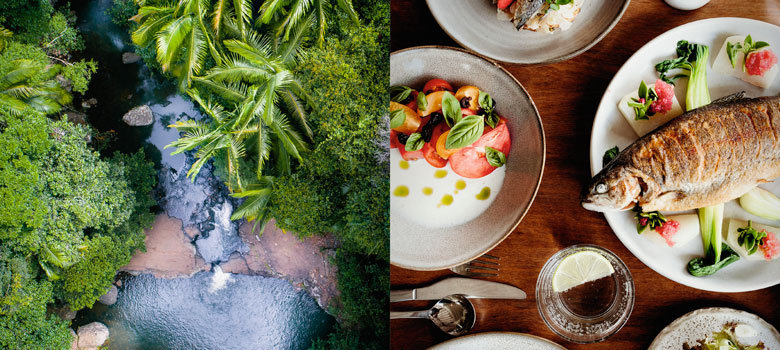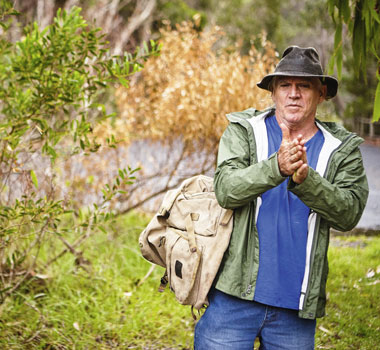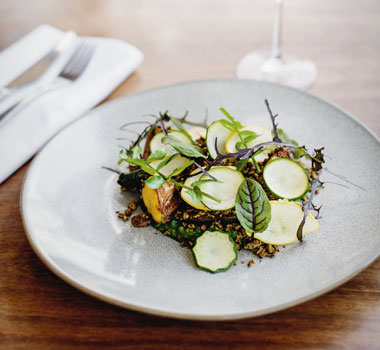
Food
Foraging Food
We are tramping along the sandy foreshore of the pacific Tweed River beneath a blue summer sky. The river banks and beyond are covered in weeds and scrubby bush, or so it seems to me, but to Peter Hardwick, it’s a veritable edible smorgasbord. Veering off to a patch of green, he kneels down, pulls out secateurs and snips away some leaves. “Warrigal greens,” he says, handing me a fistful; “best picked young when they’re tender. Blanch them and use just like spinach.”
Hardwick is a native food researcher and forager, working the coastal and riverine areas of the nature-blessed NSW Northern Rivers region. He’s been a full-time forager for Harvest Restaurant in Newrybar since 2016, but he’s been doing it a lot longer. Forty years in fact, starting as a kid digging up feral sweet potatoes and collecting pippies.
He went on to study horticulture at Ryde Horticultural College (now Ryde TAFE) in Sydney, then set about educating himself as extensively as he could, reading about and tasting his way through Australia’s cornucopia of wild foods.
While foraging is not new – both Indigenous Australians and early immigrants used to hunt and gather the local flora and fauna, in Australia’s Anglo-centric, white-bread 70s it was a novelty and Sydney suburbanites were unsure what to make of the long-haired young man harvesting fruit from street trees.
“I was a bohemian surfie wandering around the suburbs,” Hardwick says, “some people probably thought I was a weirdo. There were lots of native fruit trees planted in the streets those days and I’d get out there with my ladder and harvest them. People could be hostile – even though it was a street tree, they’d have a sense of ownership, but generally they’d just be curious and friendly and want to chat about what I was doing.”


Pictured above (from left to right): Food forager Peter Hardwick; Foraged food on the plate at Harvest Restaurant.
Edible treasures
That curiosity has increased exponentially. While the focus has often been on restaurants and chefs who’ve been vocal in their appreciation of having new flavour profiles and the opportunity to create menus with a strong sense of ‘terroir,’ the public are just as keen to get out and learn for themselves, preferably in situ. To this end, there’s been an explosion of foraging groups on Facebook, workshops, walks, TV shows and cooking classes, as well as community contributed apps and maps like Falling Fruit that help point would-be foragers to edible treasures in their own neck of the woods.
The interest is fuelled by a growing concern about the carbon footprint of our food system and the awakening consciousness of the bounty that’s been sitting there under our noses this whole time, but also, Peter Hardwick reckons, an all-too human desire to indulge in fantasies of self-sufficiency.
On a more fundamental level, foraging offers a direct and very immediate connection with nature.
“I think, sitting in our little urban boxes in front of television and computers, we miss that relationship with plants and nature our ancestors had. It’s a really primal need and when you get it filled, it’s very rewarding,” Hardwick says.
That connection to nature, he feels, can be much closer than most people imagine.
“What I think people find most fascinating and surprising is that real foraging usually happens in backyards, parks and suburban landscapes. It’s not like I’m going to be abseiling down into the forest to collect wild food.”
In fact, common edible weeds like dandelion, chickweed, oxalis, cat’s ear, ribwort, broad-leaf plantain, purslane, mallow and commelina; tasty additions to salads or an omelette, can often be found in our own backyard, along with native fruit trees such as brush cherry, riberry and lilly pilly, the fruit eaten fresh or made into jams or sauces.
Private access
While foraging on private land has no restrictions, most Australian states have regulations about foraging on public land such as state forests and require foragers to have commercial harvesting licenses. There is no harvesting at all allowed in Nature Reserves or National Parks and taking so much as a mushroom can result in heavy fines.
Hardwick and other professionals encourage wannabe foragers to use restraint and respect and encourage regeneration when appropriate when picking.
“I typically lightly tip harvest herbs, which encourages the plant to bush-up. I don’t harvest the whole plant, and I also actively regenerate areas so I increase the native habitat and the bushfood species,” he says. “I think it’s necessary for foragers to be involved in bush regeneration, because there are so many pressures on the natural environment nowadays. Foraging edible weeds is entirely a different issue because they are invasive pests, but there is still a responsibility to not spread the weeds, because they can also be a major problem to farmers.”
Hardwick, whose equipment for a day in his outdoor ‘office’ includes secateurs, a cooler chest and extendable loppers, has rich pickings in his region including the rainforest plants of macadamia nut, finger limes and Davidson’s plum, and wild succulents like sea purslane, seablight and pigface, pandanus, coastal tea tree and bunya as well as a plethora of edible weeds.
While some are eaten fresh, others, he says, benefit from different preparation techniques and in his ‘lab,’ a huge ultra-modern kitchen hidden inside an unremarkable farm shed, he does a lot of experimenting; creating ferments, pickles and a range of wild yeast vinegars from foraged plants, seeds and fruits.
While the bucolic stereotype of foraging is hard to smash, there is another side – the very real dangers for the uneducated, including inadvertently harvesting plants growing in contaminated soil; from places subject to pollutants or, in more urban areas, where a local council has possibly sprayed.
And to make sure we take her offerings seriously, mother nature has created many edible food plants with a toxic evil doppelganger, making the ability to discern the difference, a life or death skill worth cultivating.
How to be a Responsible Forager
• Start with a workshop or tour with a respected authority.
• Read as widely as you can to learn to identify edible plants Useful books include The Weed Forager’s Handbook – A Guide to Edible and Medicinal Weeds in Australia and books by Tim Low.
• Avoid foraging on busy roadside verges or places where there are possible contaminants such as effluent run-off.
• Don’t take more than you need or pick plants from the root.
• Use secateurs or scissors.
• Always ask permission if something is on private land.
• If you’re not 100% sure, don’t eat it.